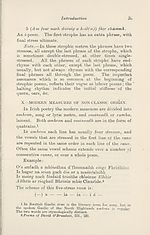Download files
Complete book:
Individual page:
Thumbnail gallery: Grid view | List view

lii.
Introduction
There are just two quatrains of amhran in the above
sense in this book, that on p. 48 (see below) and the
Ceangal, “ binding,” on p. 234: —
M’unam do Chriosd mar sgriobh na h-ostail gu leir
M’an-am a risd do bhrigh a’ bhoistidh o’n chleir
An t-aran’s am Hon ’s am pios an cdithrichear ead
Is a leithid am iomhaigh go m’anarn a dhion a pein.1
If my restoration of the phonetically spelled text is
correct, the last line is faulty. Other specimens of
genuine amhran in Scottish Gaelic may be seen in T.,
pp. 108, 114 : it is by no means common.
Gaoineadh is satisfied if the same end-rhyme is pre
served. Example:
Amhail rug an t-iolair an t-ionad i neolaibh
’S an mfol muiridhe i gcrioslachaibh bochna
Amhail rug ceannas ar cheathraibh an ledghan
Rug mo laoch-sa ar ghreas an rod leis.2
A four-stress d-rann.
A good example of caoineadh occurs on p. 223, again
in a Geangal:
Thainig plaigh air daimh nan clarsach binn,
Tha gair-bhaite an aite siol Chuinn;
Tha mnai craiteach mu d’fhagail ’sa chill:
’S i mo ghradh do lamh laidir leis am b’abhaist bhith
leinn.
Here the poet goes beyond the requirements of caoin¬
eadh, which would have been satisfied with the final
y-rhyme. The best known examples in Scottish Gaelic
are the two laments connected with the name of Mac-
1 I have tried to amend the second line, which is faulty as it
stands in the Fernaig MS.; also the first line, MS. ostil into
astail.
2 ib., II., 226.
Introduction
There are just two quatrains of amhran in the above
sense in this book, that on p. 48 (see below) and the
Ceangal, “ binding,” on p. 234: —
M’unam do Chriosd mar sgriobh na h-ostail gu leir
M’an-am a risd do bhrigh a’ bhoistidh o’n chleir
An t-aran’s am Hon ’s am pios an cdithrichear ead
Is a leithid am iomhaigh go m’anarn a dhion a pein.1
If my restoration of the phonetically spelled text is
correct, the last line is faulty. Other specimens of
genuine amhran in Scottish Gaelic may be seen in T.,
pp. 108, 114 : it is by no means common.
Gaoineadh is satisfied if the same end-rhyme is pre
served. Example:
Amhail rug an t-iolair an t-ionad i neolaibh
’S an mfol muiridhe i gcrioslachaibh bochna
Amhail rug ceannas ar cheathraibh an ledghan
Rug mo laoch-sa ar ghreas an rod leis.2
A four-stress d-rann.
A good example of caoineadh occurs on p. 223, again
in a Geangal:
Thainig plaigh air daimh nan clarsach binn,
Tha gair-bhaite an aite siol Chuinn;
Tha mnai craiteach mu d’fhagail ’sa chill:
’S i mo ghradh do lamh laidir leis am b’abhaist bhith
leinn.
Here the poet goes beyond the requirements of caoin¬
eadh, which would have been satisfied with the final
y-rhyme. The best known examples in Scottish Gaelic
are the two laments connected with the name of Mac-
1 I have tried to amend the second line, which is faulty as it
stands in the Fernaig MS.; also the first line, MS. ostil into
astail.
2 ib., II., 226.
Set display mode to:
![]() Universal Viewer |
Universal Viewer | ![]() Mirador |
Large image | Transcription
Mirador |
Large image | Transcription
| An Comunn Gàidhealach > An Comunn Gàidhealach Publications > Bàrdachd Ghàidhlig > (56) |
|---|
| Permanent URL | https://digital.nls.uk/126455690 |
|---|
| Description | This contains items published by An Comunn, which are not specifically Mòd-related. It includes journals, annual reports and corporate documents, policy statements, educational resources and published plays and literature. It is arranged alphabetically by title. |
|---|
| Description | A collection of over 400 items published by An Comunn Gàidhealach, the organisation which promotes Gaelic language and culture and organises the Royal National Mòd. Dating from 1891 up to the present day, the collection includes journals and newspapers, annual reports, educational materials, national Mòd programmes, published Mòd literature and music. |
|---|---|
| Additional NLS resources: |
|

